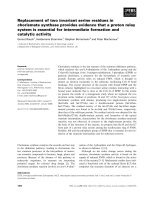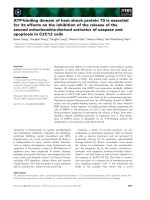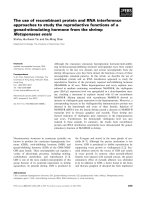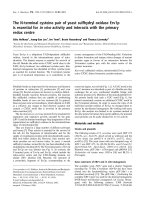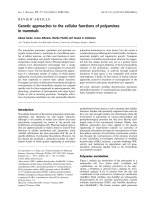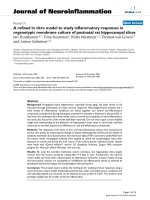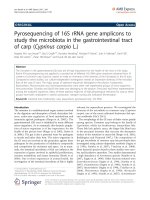Genetic approaches to study liver development in zebrafish core component sec13 in COPII complex is essential for liver development in zebrafish
Bạn đang xem bản rút gọn của tài liệu. Xem và tải ngay bản đầy đủ của tài liệu tại đây (5.05 MB, 172 trang )
GENETIC APPROACHES TO STUDY LIVER
DEVELOPMENT IN ZEBRAFISH
−−− CORE COMPONENT SEC13 IN COPII COMPLEX IS
ESSENTIAL FOR LIVER DEVELOPMENT IN ZEBRAFISH
GAO CHUAN
(Bachelor of Science, Wuhan University, P.R. China)
A THESIS SUBMITTED
FOR THE DEGREE OF DOCTOR OF PHILOSOPHY
DEPARTMENT OF BIOLOGICAL SCIENCE
NATIONAL UNIVERSITY OF SINGAPORE
2007
i
Acknowledgement
It has been five years since I started my graduate study in Singapore. I am so glad
that finally I am about to end this long journey. In the first place, I want to thank my
parents, my grandmother and my wife for their love and support.
I am grateful to my supervisor, associate professor Peng Jinrong, who
introduced me to the fabulous zebrafish research society, and guided me through the
very details of my research work in the past years. Meanwhile, I want to express my
sincere gratitude to the members of my thesis committee: A/P Hong Yunhan, Dr.
Jiang Yun-jin and Dr. Low Boon Chuan. I appreciate their invaluable comments,
suggestions and encouragement.
Group working and cooperation is very essential in conducting scientific research.
I was so lucky here that supportive colleague always surround me. I want to thank all
members of the Functional Genomics Laboratory and the Molecular and
Developmental Immunology Laboratory (Dr. Chen Jun, Dr. Cheng Wei, Dr.
Alamgir Husain, Dr. Huang Mei, Dr. Qian Feng, Dr. Yang Shulan, Aw Meng
Yuan, Cao Dongni, Du Linshen, Chang Chang Qing, Cheng Hui, Guo Lin,
Huang Honghui, Lo Lijan, Low Swee Ling, Ma Weiping, Ng Sok Meng, Ruan
Hua, Soo Hui Meng, Xu Min, Wen Chaoming, Wu Wei and Zhang Zhenhai) for
their numerous help. I also want to thank our zebrafish facility, administration
department and technical supporting team for their great service. Last but not least, I
want to acknowledge National University of Singapore and The Institute of
Molecular and Cell Biology, for financially supported my projects as well as myself.
I understand that the completion of a Ph.D degree is just the very fundamental
stage towards a scientific career. During the course I must always remind myself to be
alert, be hard working, be motivated and be passionate. In the end, I want again to
ii
thank all those ever helped me and cared about me. I am setting forth to reward their
kindness by letting them be proud of me in the years to come.
Gao Chuan
July 13, 2008
iii
Table of Contents
Acknowledgement i
Table of Contents iii
Summary ix
List of Table xi
List of Figure xii
List of Abbreviation xiv
Chapter 1. Introduction 1
1.1 Principles of developmental biology 1
1.2 The structure and functions of the liver 3
1.3 Liver organogenesis 7
1.3.1 Descriptive overview 7
1.3.2 Mechanisms controlling early stages of liver development 8
1.3.2.1 Inductive signals from surrounding tissues lead to hepatic
specification 8
1.3.2.2 Transcription factors involved in liver organogenesis 10
1.4 Zebrafish as a model to study liver organogenesis 15
1.4.1 The advantages of using zebrafish as a liver model 15
1.4.2 Study of liver development in zebrafish 16
1.4.2.1 Liver organogenesis in zebrafish 16
1.4.2.2 Study liver development through genetic approaches in
zebrafish 21
1.5 The study of COPII complex 21
1.5.1 . The COPII complex is essential for protein transport from ER to
Golgi 21
1.5.2 The recruitment and assembly of COPII transport vesicle 24
1.5.2.1 Assembly of core COPII components 24
1.5.2.2 Transport cargo selection and sorting 26
1.5.3 The structure of COPII coat 26
1.5.4 Study of COPII complex in whole organism level 31
iv
1.6 Rational and aim of the project 31
Chapter 2. General Materials and Methods 39
2.1 Fish lines and maintenance conditions 39
2.2 Chemical solutions and growth medium 39
2.3 Molecular cloning procedures: 42
2.3.1 . Polymerase chain reaction (PCR) 42
2.3.2 Purification of PCR product/DNA fragments from agarose gel 43
2.3.3 Ligation of DNA insert into plasmid vectors 43
2.3.3.1 Ligation using pGEM
®
-T /pGEM
®
-T Easy vector system 43
2.3.3.2 Insert DNA fragment into other plasmid vectors 43
2.3.4 Transformation of bacterial with plasmid 43
2.3.4.1 Preparation of DH5α E. coli competent cells 43
2.3.4.2 Plasmid transformation of E. coli cells via heat-shock
method 44
2.3.4.3 Isolation of plasmid DNA from E. coli 44
2.4 DNA sequencing 44
2.5 Zebrafish genomic DNA preparation 45
2.5.1 Prepare genomic DNA from adult zebrafish 45
2.5.2 Prepare genomic DNA from zebrafish embryos 46
2.6 RNA extraction 47
2.7 Northern blot analysis 47
2.7.1 Probe Preparation 47
2.7.2 RNA sample preparation 47
2.7.3 Hybridization analysis 48
2.8 5’ and 3’ RACE 49
2.9 RT-PCR 49
2.10 Sectioning of zebrafish embryo 49
2.10.1 Wax-embedded sectioning 49
2.10.2 Cryosectioning 49
2.11 Cell culture 50
v
2.11.1 Cell lines and growth condition 50
2.11.2 Subculturing cells 50
2.11.3 Cell transfection 51
2.12 Immunofluorescence 51
2.13 Western blot 52
2.13.1 Protein sample preparation 52
2.13.2 SDS PAGE gel running and membrane transfer 53
2.13.3 Signal detection of target protein 53
2.14 In situ hybridization 55
2.14.1 . Preparation of labeled RNA probes by in vitro transcription 55
2.14.2 Whole mount in situ hybridization for phenotype characterization 55
2.14.3 High throughput whole mount in situ hybridization for genetic
screening 57
2.15 Microinjection 57
2.15.1 Preparation of mRNA, morpholino, and needles 57
2.15.2 Microinjection 58
2.16 Alkaline phosphatase staining 58
2.17 Alcian blue staining 59
2.18 Transmission Electron Microscopy (TEM) 59
Chapter 3. Genetic screening for zebrafish mutants with liver defects 60
3.1 Introduction 60
3.2 Materials and Methods 63
3.3 Results 63
3.3.1 67 out of 71 putative mutant lines were reconfirmed 63
3.3.2 Preliminary characterization of mutants in group A and B 67
3.4 Discussion 72
Chapter 4. Positional cloning of sec13
sq198
73
4.1 Introduction 73
4.2 Materials and methods 75
4.2.1 Preparation of mapping pairs 75
vi
4.2.2 Mapping genomic DNA preparation 75
4.2.3 Strategy for mapping 76
4.2.3.1 Rough mapping 76
4.2.3.2 Intermediate mapping 79
4.2.3.3 Fine mapping 79
4.2.3.4 Candidate gene approach 81
4.3 Results 81
4.3.1 Genome scanning to identify SSLP markers flanking the mutation in
m198 81
4.3.2 Intermediate mapping 84
4.3.3 Fine mapping located the m198 mutation to a genomic DNA region
of ~54 kb 85
4.3.4 m198 carries a point mutation in sec13 gene 87
4.3.5 The mutation in sec13 gene caused the phenotype in mutant line 198 91
4.3.5.1 Mutant phenotype can be rescued by wild-type sec13
mRNA injection 91
4.3.5.2 Mutant Phenotype can be mimicked by morpholino
injection 93
4.4 Discussion 95
Chapter 5. Phenotype characterization of sec13
sq198
mutant 97
5.1 Introduction 97
5.2 Materials and methods 97
5.3 Results 98
5.3.1 General appearance of the sec13
sq198
mutant 98
5.3.2 Phenotype in digestive organs 100
5.3.2.1 Liver specification and budding are not affected in the
homozygous mutant 100
5.3.2.2 sec13
sq198
Mutant has normal endoderm differentiation 100
5.3.2.3 Mutant is arrested at expansion growth in digestive organs
at 3 dpf 104
5.3.3 Phenotype in other tissues and organs 109
vii
5.3.3.1 The sec13
sq198
is also impaired in formation of the skeleton
cartilage 109
5.3.3.2 Blood vessel and pronephric duct are not obviously affected
by the mutation 110
5.4 Discussion 111
Chapter 6. Study of the Sec13
sq198
mutant protein at the cellular and
biochemical levels 113
6.1 Introduction 113
6.2 Materials and methods 114
6.3 Results 114
6.3.1 Sec13
sq198
is a carboxyl-terminal truncated protein 114
6.3.2 Expression pattern of sec13 and sec31A in zebrafish 116
6.3.3 Sec13 and Sec31A co-localized in a variety of cell types in zebrafish120
6.3.4 Sec13
sq198
fails to form a complex with Sec31A 124
6.3.4.1 Sec13
sq198
fails to co-localize with Sec31A in vivo 126
6.3.4.2 Sec13
sq198
fails to be immunoprecipitated with Sec31A 128
6.3.5 sec13
sq198
mutation disrupted the secretory pathway 129
6.4 Discussion 133
Chapter 7. Phenotype characterization of the def
hi429
mutant 135
7.1 Introduction 135
7.2 Materials and methods 135
7.3 Results 135
7.3.1 Major digestive organs in the def
hi429
mutant are severely hypoplastic.
135
7.3.2 def
hi429
mutant has normal digestive organ specification 138
7.3.3 def
hi429
mutant is arrested at expansion growth of the digestive
organs 140
7.4 Discussion 145
Chapter 8. General Conclusions and Future Prospects 146
Appendix 1 Molecular probes used in the in situ hybridization 149
Appendix 2 Mapping panel 150
viii
Appendix 3 Methods for sec13
sq198
mutant genotyping 152
References 154
ix
Summary
The liver is one of the most essential organs in human body. However, the
embryonic development of the liver has not been well understood. In this project we
utilized zebrafish, Danio rerio, as a model organism to study genes which are
involved in liver organogenesis via genetic approach.
Firstly, forward genetic screening was applied to identify zebrafish mutants with
smaller or invisible liver, which could be signs of defects in hepatogenesis or hepatic
outgrowth. 71 putative liver defect mutants, which came from 54 F2 families, were
obtained initially. Subsequently, outcross and preliminary characterization narrowed
our scope to 15 individual lines which have no major general defects except for
small-liver or no-liver phenotype. These mutant lines are valuable resources for the
cloning of genes important for liver development.
Secondly, one of the small-liver mutant sec13
sq198
was selected for positional
cloning of the mutated gene. The mutation site was identified to be within the sec13
gene in linkage group 22. It is an intronic thymine to adenine transition, which creates
a new splicing receptor site and results in a carboxyl-terminal truncated protein as
confirmed by western blot.
Thirdly, detailed phenotype characterization of the mutant phenotype was
performed. Whole mount mRNA in situ hybridization with organ specific as well as
pan-endoderm probe suggested that the liver specification, budding and initial growth
is not affected in the homozygous mutant. However, the expansion growth of the liver,
as well as other digestive organs such as the intestine and pancreas, is arrested after 3
dpf. Furthermore, impaired development of skeleton cartilage was also observed as
revealed by alcian blue staining.
Finally, functional study of the truncated gene product, Sec13
sq198
, was carried
out in both zebrafish and human cell line. Sec13 was known to interact with Sec31A
to form the out layer of the COPII complex, which is essential for the protein and
lipid transport from ER to Golgi. Sectioning immuno-staining revealed that Sec13 and
Sec31A express at high level in zebrafish liver, intestine, exocrine pancreas and
skeleton cartilage cells. Cellular localization study in Hela cells and
co-immunoprecipitation analysis in 293T cells indicated that Sec13
sq198
failed to
interact with Sec31A. In addition, although Sec13 level is constant in all embryonic
x
stages in zebrafish, Sec31A is not detectable prior to 2 dpf by western blot.
Transmission electron microscopy revealed a misplacement of ECM and a disrupted
ER and Golgi structure in mutant
skeleton cartilage cells, which indicated defects in
secretory pathway.
Combine all data in our hands, we propose that the loss-of-function sec13
sq198
mutation disrupts the proper COPII mediated protein transportation in zebrafish
embryo and that causes the growth arrest in the liver, the intestine, the pancreas and
the skeleton cartilage.
xi
List of Table
Table 2-1. Typical reaction composition of PCR 42
Table 2-2. Typical thermal cycler conditions of PCR 42
Table 2-3. Typical reaction composition of sequencing PCR 45
Table 2-4. Typical thermal cycler condition of sequencing PCR 45
Table 2-5. 1.3% Denaturing RNA gel for northern blot analysis (50 ml) 48
Table 2-6. Preparation of SDS PAGE gel 53
Table 2-7. Methods for target protein detection in western blot analysis 54
Table 3-1. Summary of preliminary characterization result 68
Table 4-1. Intermediate mapping 84
Table 4-2. Putative genes encoded by the DNA region defined by the last two markers 87
xii
List of Figure
Figure 1-1. Developmental history of zebrafish 2
Figure 1-2. The structure of the human liver 6
Figure 1-3. Diagram illustrating stages of liver development 9
Figure 1-4 Signals and tissue interactions regulate liver organogenesis 13
Figure 1-5. Time course of liver budding in zebrafish 19
Figure 1-6. Liver growth in zebrafish 20
Figure 1-7. Intracellular vesicular traffic and transport vesicles 23
Figure 1-8. COPII vesicle formation and the selective uptake of cargo proteins 25
Figure 1-9. The cage-like COPII complex 27
Figure 1-10. 30A° resolution map of the Sec13/Sec31 cage 29
Figure 1-11. Organization of the assembly unit in the COPII cage 30
Figure 3-1. Schematic show of mutagenesis, crossing and screening 61
Figure 3-1. Schematic show of mutagenesis, crossing and screening 61
Figure 3-2-A. Putative mutants in Group A 64
Figure 3-2-B. Putative mutants in Group B 65
Figure 3-2-C. Putative mutants in Group C 66
Figure 3-3. Further classification of mutants in Group B 69
Figure 4-1. 3 dpf prox1 staining in m198 74
Figure 4-2. Principle of bulk segregation analysis (BSA) 77
Figure 4-3. The composition of mapping pools 77
Figure 4-4. Format of genome scanning 78
Figure 4-5. Schematic show of the Fine Mapping strategy 80
Figure 4-6. Linkage analysis between m198 mutation and SSLP markers on the
linkage group 22 82
Figure 4-7. The m198 mutation is flanked by z10321 and z42708B 83
Figure 4-8. Contig view of the region harboring the m198 mutation 85
Figure 4-9. Fine mapping 86
Figure 4-10. sec13 is mutated in m198 89
xiii
Figure 4-11. Wild-type sec13 mRNA can rescue the m198 phenotype 91
Figure 4-12. Test of sec13 splicing morpholino 93
Figure 4-13. Morpholino mimicking 94
Figure 5-1. General appearance of sec13
sq198
99
Figure 5-2. Liver specification is not affected in sec13
sq198
101
Figure 5-3. sec13
sq198
has normal endoderm differentiation at 2 dpf 102
Figure 5-4-A. sec13
sq198
is arrested at expansion growth of digestive organs 105
Figure 5-5. TEM image of intestinal epithelium 108
Figure 5-6. Defects in cartilage formation in sec13
sq198
revealed by alcian blue
staining 109
Figure 5-7. 4 dpf alkaline phosphatase staining 110
Figure 6-1. Sec13
sq198
is a truncated protein 115
Figure 6-2. sec13 expression during embryogenesis 117
Figure 6-3. sec13 expression pattern 118
Figure 6-4. Temporal expression pattern of Sec13 and Sec31A 119
Figure 6-5. Sec13 is co-localized with sec31A in wild-type zebrafish 121
Figure 6-6. Immunofluorescence of Sec13 and Sec31A in mutant section 123
Figure 6-7. Protein sequence alignment of zebrafish and human Sec13 124
Figure 6-8. Protein sequence alignment of zebrafish and human Sec31A 125
Figure 6-9. Sec13 and Sec31A interaction in Hela cells. 127
Figure 6-10. Co-immunoprecipitation of Sec31A and Sec13 in 293T cell 128
Figure 6-11. sec13
sq198
mutant has malformed chondrocytes and abnormal ECM
deposition 130
Figure 7-1. General appearance of 5.5 dpf def
hi429
mutant 136
Figure 7-1. General appearance of 5.5 dpf def
hi429
mutant 136
Figure 7-2. Gallbladder and intestinal bulb of 5 dpf def
hi429
mutant 137
Figure 7-3. Expression pattern of early endoderm markers in def
hi429
mutant 139
Figure 7-4. Arrested digestive organs in def
hi429
mutant 141
xiv
List of Abbreviation
BCIP 5-bromo-4-chloro-3-indolyl phosphate
BMP bone morphogenetic protein
BSA
1
bulk segregation analysis
BSA
2
bovine serum albumin
CIP calf intestinal alkaline phosphatase
CLSD
Cranio-lenticulo-sutural dysplasia
CM centimorgan
COP coat protein complex
def
digestive-organ expansion factor
DEPC Diethylpyrocarbonate
DIG digoxigenin
DMSO Dimethyl sulfoxide
dpf days post-fertilization
DTT
Dithiothreitol
elaA elastase A
ENU N-ethyl-N-nitrosourea
ER
endoplasmic reticulum
FBS fetal bovine serum
FCS fetal calf serum
FGF fibroblast growth factor
GFP green fluorescent protein
hnf
hepatocyte nuclear factor
hpf hours post-fertilization
ifabp
intestine fatty acid binding protein
lfabp
liver fatty acid binding protein
MGH Massachusetts General Hospital
NBT nitro blue tetrazolium
npo nil per os
ORF open reading frame
PAGE
polyacrylamide gel electrophoresis
PCR polymerase chain reaction
PFA paraformaldehyde
PTU
1-phenyl-2-thiourea
RACE rapid amplification of cDNA ends
rfp
red fluorescent protein
RT-PCR reverse-transcription polymerase chain reaction
SSLP simple sequence length polymorphism
STM septum transversum mesenchyme
TEM transmission electron microscope
TIP TATA box interaction protein
WISH whole mount in situ hybridization
1
Chapter 1. Introduction
1.1 Principles of developmental biology
Almost all multicellular living beings undergo sexual reproduction start from a
single fertilized egg, or zygote. Mitosis division of the zygote initiates a series of slow
and progressive changes, such as the arising of germ layers, proliferation of cell
linages and subsequent formation of different tissues and organs. This process does
not stop at birth but lasts for the whole lifespan of the organism. We usually address
this process as developmnet, which ensures the existance and reproduction of
organisms. Developmetnal Biology concentrates on the amazing and dynamic
changes during the development process. It is a science about becoming rather than
being. It investigates the formation of organisms rather than their structure and
maintenance. Developmental biology consists six general aspects.
1) Differentiation: how hundreds of cell types arise from a single cell with the
same genetic material;
2) Morphogenesis: how the differentiated cells are organized in a predetermined
order to form and arrange intricate tissues and organs;
3) Growth: how the division of numerous cells in hundreds of types is regulated
in a concert;
4) Reproduction: how the male and female gametes are set apart and instructed to
form the zygote;
5) Evolution: how the changes in development are inherited to the next
generation;
6) Environmental integration: how the development of an organism is affected by
its habitat variation.
To study these topics, scientists need to coordinate different subjects of biology,
from molecular biology and biochemistry to cell biology and physiology, further to
the system biology, ecology and evolution. Traditionally, there are three major ways
to study developmental biology. The earliest is anatomical approach, which gave rise
to experimental approach. Genetic approach was built based on anatomic and
experimental approaches. Recently, molecular genetics has begun to integrate these
approaches to produce a vigorous and multifaceted science of development biology.
A multicellular organism before birth is usually refered to as an embryo. It is
developed from a zygote through distint stages of morula, blastula, gastrula and
2
organogenesis, which in a whole is named embryogenesis. Figure 1-1 illustrates the
stages of developmental history of zebrafish. After fertilization, the zygote
immediately undergoes a series of extremely rapid mitotic divisions, which is called
embryonic cleavage, and divides into thousands of smaller cells, the blastomeres. By
the end of the cleavage, the newly generated blastomeres form a sphere and the
embryo at this stage is called morula. The mitotic divisions of blastomeres slow down
after morula stage. Instead they start the arrangement of their positions which is called
as gastrulation. Gastrulation results in the establishment of the three germ layers, the
ectoderm, the endoderm, and the mesoderm. The cells of three germ layers will then
start to rearrange to form tissues and organs in a process called organogenesis, which
will last until the hatching or birth of the embryo.
Figure 1-1. Developmental history of zebrafish. The stages from fertilization through hatching
(birth) are known collectively as embryogenesis. Gametogenesis, which is completed in the sexually
mature adult, begins at different times during development, depending on the species. (The sizes of the
varicolored wedges shown here are arbitrary and do not correspond to the proportion of the life cycle
spent in each stage.) Adapted from Developmental Biology, 6
th
edition, page 40. (Gilbert, 2000)
3
After hatching or birth there will be two kinds of cells in the body, the germ cells,
which are set aside and exclusively responsible for reproduction, and the remaining
somatic cells. The germ cells include gametes (sperms and eggs) and their antecedent
cells. The formation of gametes from their precursors is called as gametogenesis.
After maturation, the gametes may be released to form a new embryo, thus a new life
cycle is started.(Gilbert, 2000)
1.2 The structure and functions of the liver
The liver is a large internal organ that presents in all vertebrates. In adult human
it is the largest parenchyma organ which consists of about one fiftieth of the total
body weight. Liver is extremely important to the body and has many essential
functions, including storage of substances, maintaining homeostasis, blood
detoxification, producing numerous enzymes for metabolism, and serving as an
endocrine/exocrine organ. In mammalian fetus, the liver is the initial site of
hematopoiesis, thus embryonic liver defects will lead to severe consequences.
As a big vascular organ, the liver serves as a reservoir for body fluids. The adult
human liver has the storage of 10-15% of total blood volume, which can be released
for lifesaving in emergency such as acute injury. Liver also stores a multitude of
substances, including glucose in the form of glycogen, vitamin B12, iron and copper
etc.
The liver plays critical roles in carbohydrate metabolism, lipid metabolism and
protein metabolism. Glucose is a critical energy source of the body and its level in
blood must be maintained in a normal but narrow range. The liver transforms
excessive glucose in the blood into glycogen through glycogenesis and stores it as
energy backup when the concentration of blood glucose is higher than normal, or
depolymerizes liver-stored glycogen via glycogenolysis and exports back into to all
over the body through blood stream when blood glucose level is low. In
circumstances that hepatic glycogen reserves become used up, the liver synthesizes
glucose from amino acids, lactate or glycerol through gluconeogenesis to meet the
body’s energy requirement.
In lipid metabolism, the liver directly oxidizes triglycerides for energy producing.
On the other hand, it is also responsible for the conversion of excessive carbohydrates
4
and proteins into fatty acids and triglyceride, and exports them to adipose tissue. The
liver synthesizes large quantities of cholesterol and phospholipids, which are either
packaged with lipoproteins and transport to the rest of the body, or excreted in bile as
cholesterol or bile acids after converting.
In protein metabolism, the most critical function of the liver is the deamination
and transamination of amino acids. It converts non-nitrogenous parts into glucose or
lipids and transforms the ammonia into urea to exit the body in urine.
The liver has very important endocrine functions. It secretes lots of serum
proteins, such as albumin, fibrinogen, prothrombin, as well as protein C, protein S and
antithrombin. These substances are extremely essential in maintaining homeostasis of
the body. The liver’s major exocrine function is to assist digestion. It generates large
amounts of bile into the digestive tract via hepatic duct. Bile contains water,
electrolytes and a variety of organic molecules including bile acids, which are critical
for digestion and absorption of fats and fat-soluble vitamins in the small intestine.
The liver collects and breaks down body wastes, including hormones such as
insulin, hemoglobin as well as some toxic substances, from blood stream. The
metabolites after breaking down are added to bile and thus eliminated from the body.
The liver is also involved in phagocytic system and immune system. It generates
macrophage to remove particulate materials and microbes in the human body. In the
immune response, the reticuloendothelial system of the liver contains many
immunologically active cells, acting as a 'sieve' for antigens carried to it via the portal
system.
The liver is among the few internal human organs which capable of natural
regeneration of lost tissue. In mouse, whole liver can be generated from as little as
25% of remaining (Michalopoulos and DeFrances, 1997). This is predominantly due
to the nature of hepatocytes, which act as unipotential stem cells. There is also some
evidence indicate the existence of bipotential hepatic stem cells, called oval cells,
which can differentiate into either hepatocytes or cholangiocytes (bile duct cells).
The functions of the liver are highly supported by its structure. In human, the
liver is located in the right upper side of the abdomen, just below the diaphragm and
right to the stomach. It exhibits a triangle shape, wide part on the right side of the
body and extending to the left side. The human liver consists of two large lobes and
two small lobes surrounded by a capsule like connective fibrous tissue, the Glisson's
capsule. The liver has a unique dual blood supply. One is arterial supply which mainly
5
comes from the hepatic artery branching from the celiac trunk, bringing fresh
oxygenated blood from the heart. Occasionally some or all of the arterial blood can
come from other branches such as the superior mesenteric artery. The other is venous
supply comes through the hepatic portal vein which is joined by the splenic vein, the
inferior mesenteric vein and the superior mesenteric vein. It brings nutrient rich blood
from the small and large intestines, the pancreas and the spleen. Blood leaving the
liver is collected in the hepatic vein which drains directly into the inferior vena
cava(Maton and Jean Hopkins, 1993). With such an arrangement, liver can process
the nutrients and byproducts of food digestion and condition blood through
detoxification and endocrine activities (Figure 1-2-A).
At the cellular level, the liver consists mainly of hepatocytes, a polarized
epithelial cell, which account for nearly 60% of all the liver cells and carry out the
major functions of the liver. Kupffer cells, cholangiocytes, stellate cells and
endothelial cells make up the rest cell population in the liver. Hepatic cells are
organized into plates separated by vascular channels, the sinusoids (Geissmann et al.,
2005). This organization is supported by the reticulin (collagen type II) network. The
sinusoids are lined by endothelial cells and sinusoidal macrophages (Kupffer cells) in
a discontinuous, fenestrated fashion. The endothelial cells have no basement
membrane and are separated from the hepatocytes by the space of Disse, which drains
lymph into the portal tract lymphatics. Kupffer cells are scattered between endothelial
cells. They are part of the reticuloendothelial system and phagocytose spent
enthrocytes. Stellate cells, which are otherwise referred to as Ito cells, can also be
found in the space of Disse and is responsible for the storage of Vitamin A and
produce extracellular matrix and collagen. Hepatocytes have surfaces facing the
sinusoids, called sinusoidal faces, and surfaces which contact other hepatocytes,
called lateral faces. Bile canaliculi are formed by grooves on some of the lateral faces
of hepatocytes. They are thin tubes that collect bile secreted by hepatocytes. The bile
canaliculi merge and form bile ductules, which eventually join to common hepatic
duct. Cholangiocytes are the epithelial cells of the bile duct. They are cuboidal
epithelium in the small interlobular bile ducts, but become columnar and mucus
secreting in larger bile ducts approaching the porta hepatis and the extrahepatic
ducts(Housset et al., 1995). Cholangiocytes modify bile by water reabsorption and
through secretion under the influence of secretin and somatostatin. This kind of cell
alignment in the liver vascular structure maximizes the exposing of hepatocytes to
6
blood flow and the bile canaliculi, thus largely facilitates the liver to conduct its major
functions (Figure 1-2-B).
Figure 1-2. The structure of the human liver. A. Anterior view of the human liver and its
surround tissues and organs, taken from />images/liver2.jpg. B. The
microscopic view of the liver structure, taken from /> .
A
B
7
1.3 Liver organogenesis
1.3.1 Descriptive overview
The liver is such an important organ yet with a relatively small numbers of
differentiated cell types. This characteristic has made the liver an attractive system for
scientists to investigate organogenesis and tissue development for decades. Previous
studies regarding liver organogenesis were mostly conducted in chick, quail, as well
as mouse and rat model systems and have brought many perspectives to the field.
Liver is an endoderm-derived organ and its developmental process is conserved
among vertebrates (Haffter et al., 1996). Liver initiation starts from the definitive
endoderm at the gastrulation stage (Zaret, 2001). In mouse embryo, gastrulation starts
at around embryonic day 6.5 (E 6.5), in which the definitive endoderm appears like a
single-cell thick epithelial sheet that covers the bottom surface of the developing
embryo. Subsequent invagination of the anterior and posterior ends of the embryo
generates the foregut and hindgut (Zaret, 2002). At around E 7, the developing mouse
liver can be morphologically identified as an outgrowing bud of proliferating
endodermal cells present in the left ventral floor (Douarin, 1975). At this early stage
the liver bud is separated from the surrounding septum transversum mesenchyme
(STM) by basement membrane (Medlock and Haar, 1983). Following the progressive
disruption of the basement membrane, the pre-hepatic cells delaminate from the
young bud and migrate into the surrounding STM to undergo rapid proliferation and
differentiation (Douarin, 1975; Medlock and Haar, 1983). These pre-hepatic cells in
STM are commonly referred to as hepatoblasts, which give rise to definitive
hepatocytes and cholangiocytes (bile duct cells) and differentiate much further in fetal
liver (Shiojiri et al., 2001). At the same stage, endothelial cells will invade the liver
bud and form the vascular structure in the nascent liver. During liver morphogenesis,
the hepatocytes become polarized. The apical domain of hepatocytes lines the
channels between cells, called canaliculi, which connect to bile ducts and drain into
intestine (Lemaigre and Zaret, 2004). The basal layer becomes juxtaposed to
fenestrated endothelium that lines sinusoids, or tissue gaps, in which blood stream
from the arterial and intestinal portal circulations flow through and reach the venous
circulation. By these means, the developing liver becomes ready to perform its
aforementioned tasks (Lemaigre and Zaret, 2004).
8
1.3.2 Mechanisms controlling early stages of liver development
Previous morphological and genetic data suggested that liver organogenesis starts
with establishment of definitive hepatoblasts. Next, hepatoblasts delaminate out of the
epithelial layer to form a discrete liver bud and meanwhile undergo fast proliferation
to increase the liver bud size. Finally, hepatoblasts differentiate into functional
hepatocytes and biliary duct cells (Duncan, 2003; Zaret, 2002) (Figure 1-3). These
early stages of liver developments are controlled delicately by a variety of
mechanisms, including response to signaling molecules from adjacent tissues and also
regulation by local transcription factors (Figure 1-4).
1.3.2.1 Inductive signals from surrounding tissues lead to hepatic
specification
In early gastrulation stage, the ventral endoderm is surrounded by a variety of tissues,
including the pre-cardiac mesoderm, septum transversum mesenchyme (STM) and
also endothelial cells. Tissue grafting experiment in chick-quail chimera system
(Douarin, 1975) and mouse model (Fukuda-Taira, 1981) suggested that the
pre-hepatic endoderm need to be in close contact with the pre-cardiac mesoderm to
acquire hepatic competency. This is consistent with morphogenic pattern during this
stage, which results in the invagination of the foregut and juxtaposing of the ventral
endoderm with the developing heart (Figure 1-3). To reveal the signaling molecules
involved in this process, Jung et al isolated the ventral endoderm from 2 to 6 somite
stage mouse embryos and cultured them in vitro. They found that fibroblast growth
factors (FGF-1 and FGF-8) could induce hepatic competency without the presence of
pre-cardiac mesoderm (Jung et al., 1999). However, since the pre-cardiac mesoderm
is tightly associated with the STM which contains BMPs (bone morphogenic protein),
Jung’s colleagues, Rossi et al argue that possible contamination of the STM could not
be excluded. To explore this possibility, they used tissue sample from BMP4
-/-
mouse
embryos together with inhibitors of BMPs and revealed that BMP signaling from the
STM is also necessary for hepatic competency (Ross et al., 2001; Rossi et al., 2001).
Combine with a concurrent report that the default fate of the ventral endoderm is to
develop into pancreas, not the liver (Deutsch et al., 2001), Rossi et al claimed that
BMPs and FGFs function in a combinational fashion to repress the pancreatic fate of
the ventral endoderm and promote the hepatic competency.
9
Figure 1-3. Diagram illustrating stages of liver development. At gastrulation the definitive
endoderm is rendered competent to follow a hepatic fate. After specification, a swelling of the ventral
endoderm generates the liver bud. The pre-hepatic cells then delaminate from the foregut and migrate
into the septum transversum. Concurrent with this phase of rapid proliferation is the hepatic cells
differentiation and liver vascularization. Taken from Duncan SA et al. 2003.
10
In addition to these two mesodermal signals, it has also been reported that
endothelial cells surrounding the early liver bud are necessary to support hepatic
differentiation and morphogenesis. However, the signaling molecules behind this
phenomenon are currently unclear. (Matsumoto et al., 2001). Furthermore, in addition
to the mouse and avian system, a recent study in a zebrafish mutant revealed that prt,
a previously unidentified Wnt2b homologue from the nearby bilateral mesoderm,
positively regulate liver specification (Ober et al., 2006).
1.3.2.2 Transcription factors involved in liver organogenesis
Gene expression is largely regulated through transcriptional control. It is expected
that specific transcription factors will play important roles during liver development.
1.3.2.2.1 Foxa family proteins
Foxa family proteins, which are also known as HNF3s (hepatic nuclear factor 3) ,
were initially identified as liver-enriched transcription factors (Lai et al., 1990) which
can bind to the promoters of the genes encoding α1-antitrypsin and transthyretin in
mammals (Herbst et al., 1991). They were shown to regulate a variety of regulatory
and metabolic proteins expressed in liver (Lee et al., 2005a). Its three isoforms, foxa1,
foxa2 and foxa3, are encoded by different genes which shares 85% sequence identity
over their DNA binding domains “winged helix” (Kaestner et al., 1994), which
consist of a helix-turn-helix motif flanked by two “wings” of polypeptide chains that
make DNA contacts (Clark et al., 1993). All foxa mRNAs express in endoderm and
later in endoderm-derived tissues, in which over 100 genes have been found to
contain the foxa binding site (Cereghini, 1996). Gene targeting studies of foxa
isoforms in mouse revealed that foxa1 null mouse embryo is perinatal lethal due to
pancreatic defects, but the liver is apparently not affected (Kaestner et al., 1999).
Foxa2 inactivation leads to defects in foregut morphogenesis and notochord formation.
The Foxa2
-/-
embryo died shortly after gastrulation (Ang and Rossant, 1994;
Weinstein et al., 1994). Foxa3 knockout does not cause liver phenotype and is not
lethal. However, the absence of Foxa3 reduces the expression of liver genes, such as
GLUT2 (Kaestner et al., 1998). In 2005, Lee et al generated conditional knock out
mouse (foxa2
LoxP/LoxP
;foxa3-Cre) system in which Foxa2 depletion is restricted to

